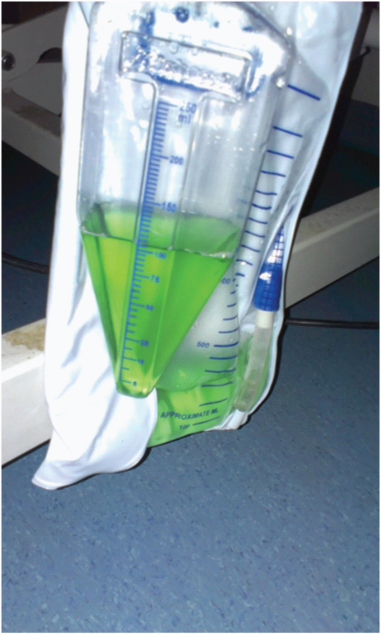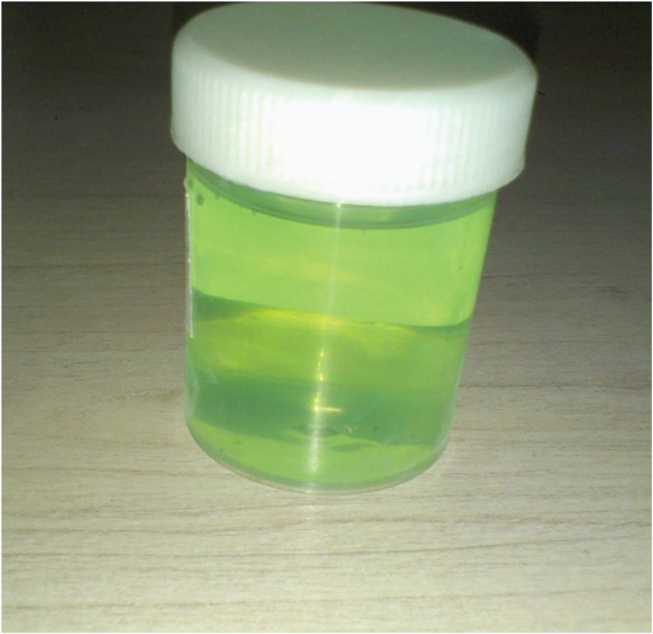Green Urine Due to Propofol: A Case Report with Review of Literature
Gautam Rawal1, Sankalp Yadav2
1 Attending Consultant-Critical Care, Rockland Hospital, Qutab Institutional Area, New Delhi, India.
2 General Duty Medical Officer-II, Chest ClinicMoti Nagar, North MCD, New Delhi, India.
NAME, ADDRESS, E-MAIL ID OF THE CORRESPONDING AUTHOR: Dr. Gautam Rawal, Flat No. 417, Dhruva Apartments, Plot no. 4, I P Extension, Patparganj, Delhi-110092, India. E-mail : drgautamrawal@hotmail.com
The change in the colour of urine is a known occurrence in an intensive care setting and is always a cause of concern to the clinicians who have to differentiate between benign and pathological causes. Herein, we present a case of 62-year-old postoperative lady, noticed to be passing green coloured urine believed to be due to intravenous Propofol administration for induction of general anaesthesia. The green colour of urine due to Propofol occurs when clearance of Propofol exceeds hepatic elimination, and extrahepatic elimination of Propofol occurs. This discolouration of urine is a rare (less than 1% cases) but a benign side effect of Propofol, which is non-nephrotoxic and gets reversed after discontinuation of the drug.
Anaesthesia, Drug side effect, Urine discoloration
Case Report
A 62-year-old female was received in surgical intensive care unit (ICU) postoperatively. She underwent a sleeve gastrectomy (Bariatric surgery) for her morbid obesity, under general anaesthesia. She was a known patient of systemic hypertension, diabetes mellitus and obstructive sleep apnea. On examination, she was conscious and oriented on her arrival in the ICU. Her vitals: Blood pressure- 160/90mmHg, heart rate-90/minute, oxygen saturation-99% on O2 @4litre/minute, temperature-98.6°F. Her chest was clear with normal heart sounds. It was noticed that she was passing grass green coloured urine, with Foley’s catheter in situ [Table/Fig-1,2]. This was alarming and cause for confusion for the intensivist and clinician, especially in a diabetic patient, as the first diagnosis, which comes in mind is Pseudomonas urinary tract infection. The patient had been thoroughly evaluated preoperative and did not show any signs/report suggestive of sepsis. She had normal liver functions, renal functions, complete haemogram, urine microscopic examination and negative urine ketones. The urine started to get clear spontaneously after about 12 hours of green discolouration. The patient had a stable postoperative period, was mobilized after 6 hours of surgery and was transferred out of the ICU the next day. She is doing well and is being regularly followed up as an outpatient. The literature for the differential diagnosis of the causes of green coloured urine was searched and the cause of green urine was attributed to the use of intravenous propofol used for the induction of her general anaesthesia.
Grass-green coloured urine, with Foley’s catheter in situ

Grass-green coloured urine

Discussion
Urine analysis is a definitive part in a patient’s evaluation of illness and colour of urine is an integral part of this assessment. To the treating physician, any change in urine colour and/or appearance is of great help and can act as a tool for diagnosis.
Discolouration of urine is a common occurrence in the setting of intensive care as there are many factors like drugs, medical illness, dyes and foods which cause changes in urine colour and it is common for the treating clinician/intensivist to notice a change in urine colour. A few examples include: orange colour urine in patients on Rifampicin or Phenazopyridine hydrochloride, red/cola colour urine in haemoglobinuria, myoglobinuria or due to taking certain food like beetroot or blackberries, deep yellow colour urine in patients on multivitamins (vitamin B complex), having hyperbilirubinemia and also dehydrated patients; brown colour urine due to medicines like metronidazole, phenytoin, nitrofurantoin, deep purple in porphyria [1,2].
Green colour urine is an unusual and intriguing rare occurrence seen in the setting of intensive care and anaesthesia. Propofol induced green colour urine is a rare phenomenal side effect considering the amount and widespread use of Propofol as an agent for the induction and maintenance of general anaesthesia and also as a short acting sedative in critical patients (on mechanical ventilation and procedural sedation) [3]. Till date, approximately 16 cases have been reported of propofol induced green urine [4–10]. The exact incidence of this phenomenon is unknown, though Blakey et al., described it at less than 1% [11].
The common causes of greenish discolouration of urine are [4–6]:
(1) Phenol containing compounds: Promethazine, Propofol, Thymol,
(2) Dyes: Indigo-blue, Indigo carmine, Carbolic acid, Flavin derivatives,
(3 Biliverdin (in cases of long standing obstructive jaundice),
(4) Amitryptyline (anti-depressant),
(5) Pseudomonas infection,
(6) Cemetidine,
(7) Indomethacin,
(8) Methylene blue (bluish green),
Propofol is mainly metabolized and conjugated in the liver and excreted in urine predominantly as 1- glucuronide, 4-glucuronide, and 4-sulfate conjugates of 2,6-diisopropyl-1,4 quinol. The green colour of urine is believed to be attributed to the presence of these phenolic metabolites [4–11]. This discolouration appears when the elimination of propofol through the hepatic route is exceeded and extrahepatic elimination occurs [4–11]. The relief for the anxious patient and the concerned clinicians is that these metabolites of propofol are biologically inactive, and the passing of green colour urine is non nephrotoxic, that is, it does not alter or reflect renal function [6,11].
Green urine has been usually described in patients on prolonged propofol infusion, though cases have been reported with short duration of use also like during induction of general anaesthesia [7,10]. In this case, the green discolouration resolved spontaneously in about 12 hours of propofol discontinuation. The previous case reports have described the time of the discolouration to vary from two hours to two days after discontinuation of propofol [7–10]. The benign side effect of propofol leading to greenish discolouration of urine can be recognized by taking a detailed history of the drugs given to or taken by the patient and thus will help in avoiding unnecessary lab investigations and anxiety associated with the rare presentation.
Conclusion
This case of green urine demonstrated a rare benign side effect of propofol, which if not known to the clinicians, would lead to panic and irrelevant investigations. This can also be distressing not only to the anxious patient and patient’s family, but also to the treating clinicians.
[1]. Raymond JR, Yarger WE, Abnormal urine colour: Differential diagnosisSouth Med J 1988 81:837-41. [Google Scholar]
[2]. Shim YS, Gil HW, Yang JO, Lee EY, Kim SH, Hong SY, A Case of Green Urine after ingestion of HerbicidesThe Korean Journal of Internal Medicine 2008 23(1):42-44. [Google Scholar]
[3]. Bryson HM, Fulton BR, Faulds D, Propofol: An update of its use in anaesthesia and conscious sedationDrugs 1995 50(3):513-59. [Google Scholar]
[4]. Shioya N, Ishibe Y, Shibata S, Makabe H, Kan S, Matsumoto N, Green urine discolouration due to propofol infusion: A Case reportCase Reports in Emergency Medicine 2011 2011:242514 [Google Scholar]
[5]. Ananthanarayan C, Fisher JA, Why was the urine green?Can J Anaesth 1995 42(1):87-88. [Google Scholar]
[6]. Barbara DW, Whalen FX, Propofol induction resulting in green urine discolourationAnaesthesiology 2012 116:924 [Google Scholar]
[7]. Lee JS, Jang HS, Park BJ, Green discolouration of urine afterpropofol infusionKorean Journal of Anaesthesiology 2013 65(2):177-79. [Google Scholar]
[8]. Regensburger M, Huttner HB, Doerfler A, Schwab S, Staykov D, Propofol-related urine discolouration in a patient with fatal atypical intracerebral haemorrhage treated with hypothermiaSpringer Plus 2014 3:551 [Google Scholar]
[9]. Rawal G, Garg N, Wani UR, Yadav S, Green urine: A rare benign side effect of PropofolInt J Med Res Rev 2015 3(1):136-38. [Google Scholar]
[10]. Pedersen AB, Kobborg TK, Larsen JR, Grass-green urine from propofol infusionActa Anaesthesiol Scand 2015 59(2):265-67. [Google Scholar]
[11]. Blakey SA, Hixson-Wallace JA, Clinical significance of rare and benign side effects: Propofol and green urinePharmacotherapy 2000 20:1120-22. [Google Scholar]